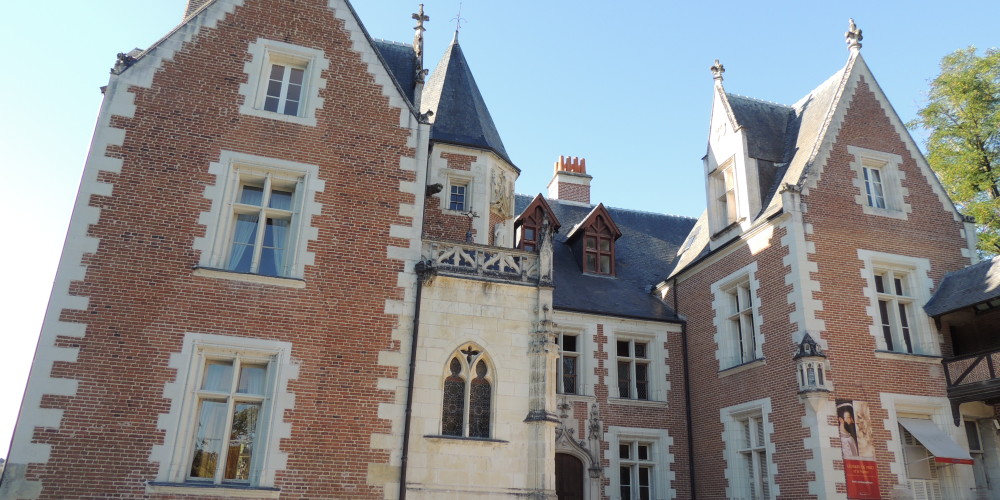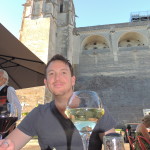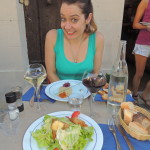As we had just spent two glorious nights at Chateau de la Barre exploring the Loire Valley’s grand Chateaux (including Chenonceau, Chambord and Cheverny – read more in my post “The Loire Valley Chateaux“), we only booked one night in Amboise, one of the Loire Valley’s bigger cities.
With such limited time in Amboise, we limited our site-seeing to one “must see site” which was Leonardo da Vinci’s old home, and now a museum honouring his work – Château du Clos Lucé.
Clos Lucé is located about 500 metres from the royal Château d’Amboise (the number two site on our list, which we unfortunately did not have time to see properly) and is truly beautiful. With its charcoal roof tiles, pink bricks and cream trim, it looks like a giant gingerbread house – and, amazingly, very similar to the original from more than 500 years ago!
Château du Clos Lucé 

Famous primarily for being the official residence of Leonardo de Vinci for the three years prior to his death, Clos Lucé was King Francis’ summer residence and de Vinci was invited there to live by special invitation of King Francis. De Vinci arrived in 1516 after travelling from Italy with a mule and three of his partly finished paintings – the Mona Lisa, Sainte Anne and St Jeane de Baptise, all of which were finished during his time at Clos Lucé. Francis thought very fondly of Leonardo and referred to him as ‘my father’ – the two of them used to visit each other regularly via the underground passageway which connected the Château d’Amboise (where the King lived) and Clos Luce.
View of the Château d’Amboise from Clos Lucé

Our tour of Clos Lucé started with a self guided walking tour through the residence and started at the watchtower. The entire house was furnished and restored to represent exactly how it would have looked during de Vinci’s time, which was beautiful to see.
Leonardo’s Dining Room

After walking through the walk tower, we entered Leonardo’s actual bedroom, and the place where he passed away in 1519. It was very very surreal to walk the floors where we knew one of the most famous, and greatest, humans of our time walked daily, even more bizarre to think he died there. Interestingly, he also wrote his will in this tool shortly before he died, whereby he left all of his manuscripts, books of drawings and sketches to his protege Francesco Melzi.
Next up we saw the Oratory where Queen Anne of Brittany would go to pray after losing all her children at an early age; as well as the Renaissance great Hall where de Vinci would entertain his many prestigious, and common guests. The furniture, chests and tapestries that were on display were what guests would have seen – crazy amazing! The kitchen was next, and this was the domain of de Vinci’s faithful friend and cook who prepared all of his vegetarian meals for him.
After viewing the living quarters of Clos Lucé, it was time to explore the four basement rooms, dedicated to Leonardo the Engineer. Besides his painting, de Vinci also found time to embrace the engineering genius that he is equally well known for – drawing inspiration from his varied readings, research and his ability to see technicalities as easily as he saw creative.
There was a spectacular display at Clos Lucé that demonstrates the brilliance of the master – over 50 models of de Vinci’s drawings have been built, ranging from military engineering, instruments, mechanisms, architecture, even maritime engineering. It was really quite amazing to see how de Vinci foresaw things such as helicopters, drawbridges and other items hundreds of years before they would be able to be further developed.
Some of Leonardo’s inventions

After spending a couple of hours wandering around the inside of Clos Lucé and marvelling at the genus of de Vinci, we sought out the beautiful gardens and the sunshine. I was not expecting to find much except for some well planned rose gardens, but was pretty much blown away by the time and energy taken into curating yet another amazing addition to Clos Lucé.
Stil more of Leonardo’s models and prototypes were demonstrated throughout the gardens, with 20 giant interactive machines going including the helicopter, the fan type machine gun, the paddle boat, the swing bridge. Besides the technical appeal of the gardens there was also the lush botanical gardens, spread over a hectare – we were really quite blown away.
Entry to the grounds was €13.50 per person and I would highly recommend, although I do think seeing Château d’Amboise would provide an additional layer to the history of Amboise itself.
By the time we finished our touring, we were both feeling the heat and decided a nice cold glass of wine was in order. It was pretty early still, close to 5pm, but rather than going back to our accommodation and driving in again, we thought we would grab an early dinner.
We wandered throughout the pretty cobblestone streets until we found a pedestrian street that was lined with bars and restaurants (admittedly, in hindsight, I am pretty sure this was the biggest tourist trap!), and after checking out a few menu’s we snagged a table outside at Sarl Chez Bruno so we could watch the sun set and people watch. It was here that we began our love affair with foie gras (I know, I know, it is a controversial topic, but truly, we were in France to explore their culture and food, and I was adamant about trying all of France’s “specialities de la region”).
We started with a shared platter of foie gras and fresh bread (€12) and a chèvre (goats cheese) salad for €7, complemented perfectly by a couple of glasses of the local Gourmandaise wine at €6 each. As you can see, the chilled wine went down a treat!
Loving Amboise (and its wine!)
After a long day walking Clos Lucé it didn’t take long for us to start feeling abit tired once our meals had digested. Luckily our accommodation at a stunning, unique troglodyte home (look it up – it means a cave house built into limestone! cool huh?!) was less than 5kms away by car so it didn’t take long for us to arrive back.
Our accommodation in the troglodyte home was one of the most unique, and we were blown away when we arrived – which was a relief as we had booked it via Airbnb and despite the reviews all being glowing for the hosts and accommodation, you still cannot be sure until you arrive.
Dave in front of our troglodyte home for the night 
Our host, Marie, was beautiful and showed us around, explaining the extensive gardens/land at the top of the limestone cliff the home was built into were actually part of the property as well. Marie lived next door in the main house, whereby our part of the house was separated by corridors built into the limestone. It was really really cool – both literally and figuratively – the limestone kept it very cold inside, and staying inside a cave was also pretty amazing!
We spent an hour or two chillaxing in the evening sun, and planned our route for tomorrow – with Dave as driver, that leaves me as chief navigator, a job I do not take lightly!
Planning our route
We loved our time, albeit short and sweet, in Amboise, and I would lot to go back and spend longer exploring the town itself. The accommodation was such a unique experience as well – i would definitely encourage anyone considering it to take advantage of AirBnB and the experienced it offers!


